Menus
- What you must remember
- Themore
- Theless
- Make yourYamaha FZR 1000 EXUP 1992
- Opinion
- Replaces
- Performances
- The technical aspect
- Competitors
- Gallery
- Related articles
1986, Suzuki releases a second missile on the road, this time in 1100cc. Yamaha, which was already stolen from the limelight by the GSX-R 750 the previous year, has no intention of being fooled. Taking an additional year to prepare its response, the tuning fork brand unveiled in 1987 an astonishing FZR 1000. Astonishing, because while retaining the techniques inaugurated on the FZ 750, Yamaha has given its new model all the aesthetic aggressiveness that the FZ lacked in the face of the Suzuki GSX-R 750..
On the program: Genesis 989cc engine with 20-valve cylinder head and cylinder bank tilted 45 ° forward (lowering the center of gravity and vertical intake ducts for better cylinder filling, etc.), perimeter frame type Aluminum deltabox, full fairing incorporating 2 round optics. This FZR is a direct competitor of the Suzuki GSX-R by its displayed sportiness, while remaining skilfully an alternative to the road-sports Honda CBR 1000 F and Kawasaki ZX-10 Tomcat; a very nice demonstration of the splits.
The Genesis engine develops 135 horsepower at 10,000 rpm, 5 more than the big GSX-R, which nevertheless benefits from a few more cubic centimeters. It is brighter at the top and also more flexible thanks, in particular, to the 20-valve cylinder head. This first version will immediately demonstrate good reliability (apart from the recurring weakness of a gearbox bearing). The GSX-R 1100 keeps the prize for the meanest engine and its thug character will also allow it to have a very good career. The 100 hp version of the FZR, although less tumultuous in the upper part of the tachometer, retains a strong character and a large torque.
The cycle part, without being more innovative than that of the Suzuki, is at least equal play. The Deltabox which will become one of the trademarks of the blues is very efficient; rigid while being light. Yamaha equipped its high-end sports car with high-quality suspensions and a cutting-edge braking system for the time (dual 310 mm discs at the front clamped by 4-piston calipers). Braking nevertheless remains delicate in sporty driving due to the respectable weight of the machine (197 kg empty).
1989 saw the release of the biggest evolution of the 1000. The engine won only 13cc but above all the now famous EXaust Ultimate Powervalve or EXUP. This valve on the exhaust makes it possible to vary the flow of exhaust gases in order to optimize the torque at mid-speed while maintaining maximum power in the upper part of the tachometer. The FZR thus gains 10 horsepower at the same maximum speed (10,000 rpm) and a more substantial torque curve. The Deltabox frame evolves for more rigidity. The spars gain in section. The big sports car also offers new brake discs and calipers, for more progress and bite, a 17-inch rear wheel (18 for the first version) and larger section tires. Other side of the coin, these modifications increase the weight of the beast by a good dozen kilos (209 kg empty).
And like its competitor Suzuki, Yamaha is embarking on a perpetual improvement of its top-of-the-range model. 1991, offers its share of modifications: a new cycle part, still of type Deltabox, as well as a fork of type UPSD (upside-down), supposed to bring more rigidity and precision of the front axle. Another visible feature of this vintage, the abandonment of the double round optic for a trapezoidal headlight similar to that of the FZR 600 of the time. The line loses a lot in aggressiveness and contrasts a little with the new high-tech elements such as the inverted fork hidden behind the front mudguard more imposing than the previous one (protection of the oil seals obliges).
And as the saying goes, it is only fools who do not change their mind, Yamaha takes up the idea of double optics in 1993. The YZF 750 R released the same year takes a big step forward , both in terms of sportiness and style. Yamaha has therefore logically chosen to offer its FZRs (the 1000, but also the 600 which has greatly evolved that same year) a style common to this very promising novelty. In the process, the 1000 also gets new front brakes. The discs return to a size of 310mm, but are fitted with 6-piston calipers (just like the Suzuki GSX-R 1100).
The marketing of this model will end in 1995 for France, after 13,659 copies sold for France alone. First replaced by a YZF 1000 ThunderAce much more road / sport oriented, it will only find its true descendants in the YZF 1000 R1 presented in 1998. Today very far from modern ultra sports cars, this FZR 1000, with the GSX -R 1100, are still today the best representatives of the big production sports cars of the early 90s. A time when you had to put up with a respectable weight when you wanted to benefit from a hairy berlingot.
What you must remember
Themore
Theless
Make
yourYamaha FZR 1000 EXUP 1992
Estimate, calculate and compare the cost of insuring your motorcycle.
Calculate the cost of
insurance
Test the price of the motorcycle insurance specialist
Opinion
on 0 opinion
users
Read the reviews
Replaces
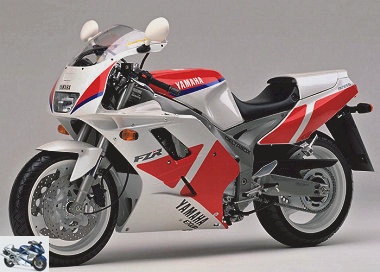
FZR 1000 EXUP 1991
Model marketed in
1991
1992
Performances
-
Max speed:
approx. 260 km / h -
Acceleration
0 to 100: 2.90 s -
Consumption
medium: 5.90 l
The technical aspect
Yamaha FZR 1000 EXUP 1992
- Frame
- Frame: Perimeter aluminum deltabox
- Tank: 19 liters
- Seat height: 775 mm
- Length: 2,205 mm
- Width: 745 mm
- Height: 1170 mm
- Wheelbase: 1,470 mm
- Dry weight: 209 kg
- Weight in running order: 235 kg
- Train before
- Telehydraulic inverted fork Ø 43 mm, deb: 130 mm
- 2 discs Ø 320 mm, 4 piston calipers
- Front wheel:
130/60
– 17
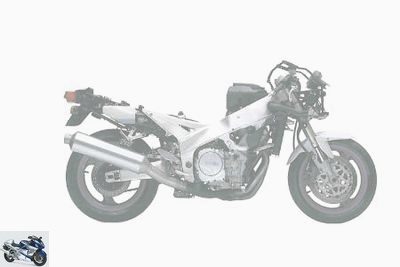
- Transmission
- 5-speed gearbox
- secondary by chain
- Rear axle
- Mono-shock absorber, deb: 130 mm
- 1 disc Ø 267 mm, 2 piston caliper
- Rear wheel:
170/60
– 17
- Motor
- 4 Cylinders
in line
, 4 stroke - Cooling: liquid
- 4 carburettors Ø 38 mm
- 2 ACT
- 5 valves per cylinder
-
1,002 cc
(75.5 x 56 mm) -
145
ch
at 10,000 rpm -
10.90 mkg
at 8,500 rpm - Weight ratio /
power
: 1.44
kg / hp - Compression: 12: 1
- Crit’air:
Detached pieces
exhaust
motor
fluid
electricity
filtration
braking
chain kit
Competitors
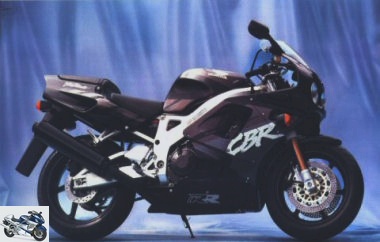
Honda CBR 900 RR FIREBLADE 1992
Gallery
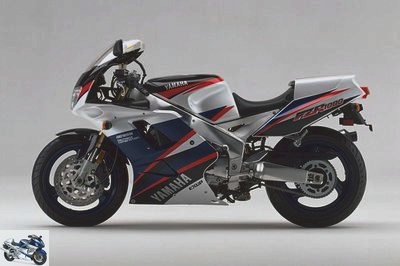

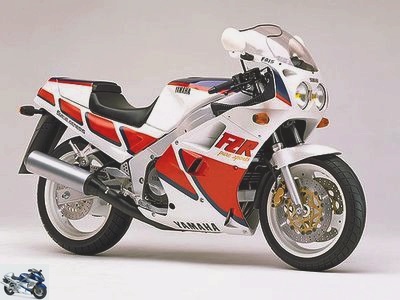

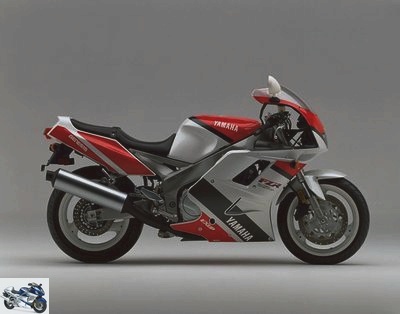
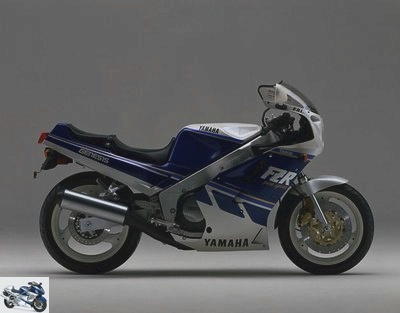
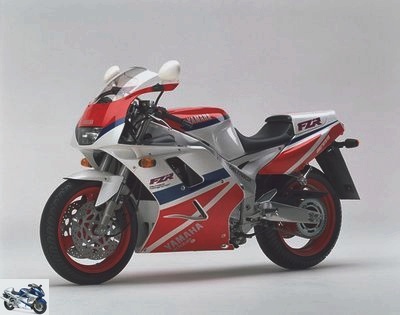
Related articles
-
1986, Suzuki releases a second missile on the road, this time in 1100cc. Yamaha, which was already stolen from the limelight by the GSX-R 750 the…
-
1986, Suzuki releases a second missile on the road, this time in 1100cc. Yamaha, which was already stolen from the limelight by the GSX-R 750 the…
-
1986, Suzuki releases a second missile on the road, this time in 1100cc. Yamaha, which was already stolen from the limelight by the GSX-R 750 the…
-
1986, Suzuki releases a second missile on the road, this time in 1100cc. Yamaha, which was already stolen from the limelight by the GSX-R 750 the…
-
1986, Suzuki releases a second missile on the road, this time in 1100cc. Yamaha, which was already stolen from the limelight by the GSX-R 750 the…
-
1986, Suzuki releases a second missile on the road, this time in 1100cc. Yamaha, which was already stolen from the limelight by the GSX-R 750 the…
-
1986, Suzuki releases a second missile on the road, this time in 1100cc. Yamaha, which was already stolen from the limelight by the GSX-R 750 the…
-
1986, Suzuki releases a second missile on the road, this time in 1100cc. Yamaha, which was already stolen from the limelight by the GSX-R 750 the…
-
…is a perpetual quest that Yamaha has dangerously approached the limit from a stylistic point of view. It’s quite simple: the brand with 3 tuning forks…
-
Yamaha’s new sportivo-GT is a new kind of motorcycle. Not in its general concept but in its conception. Another competitor for the CBR 1000 F and ZZR…